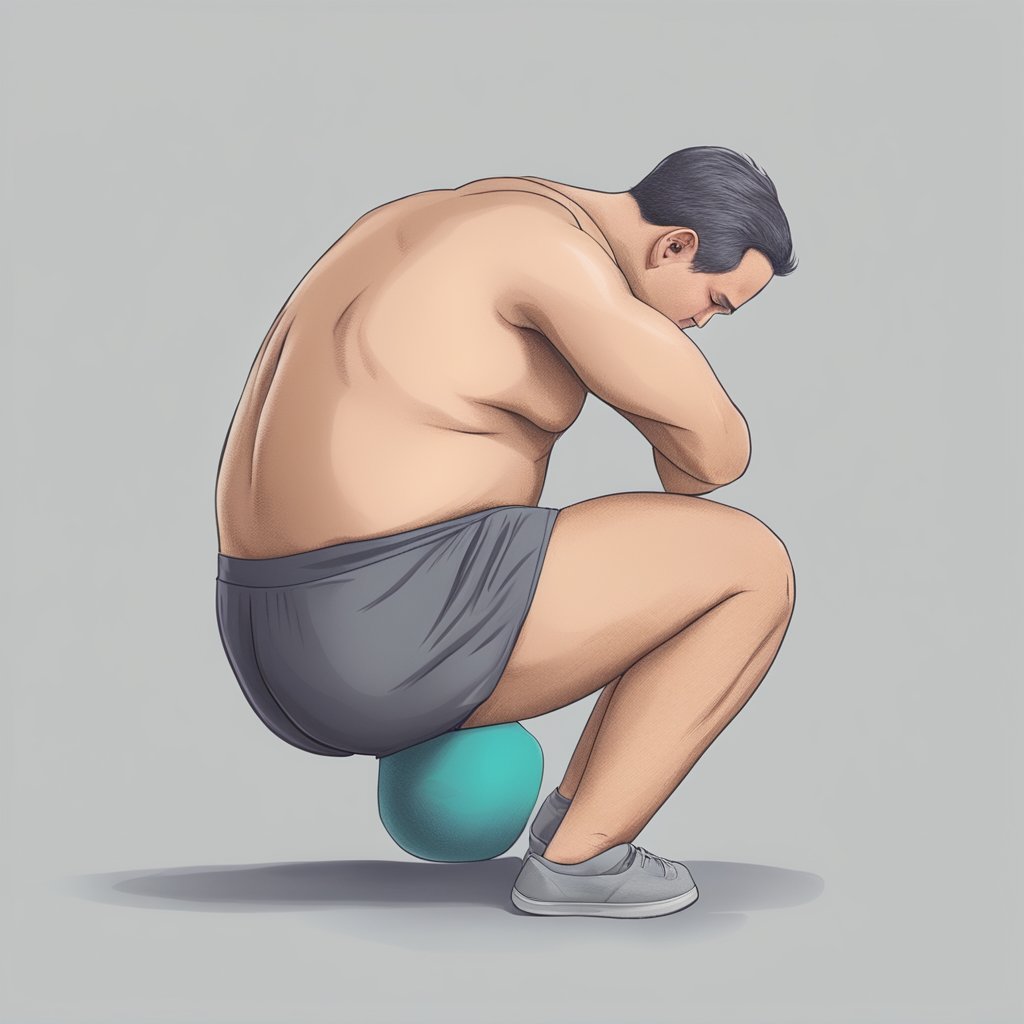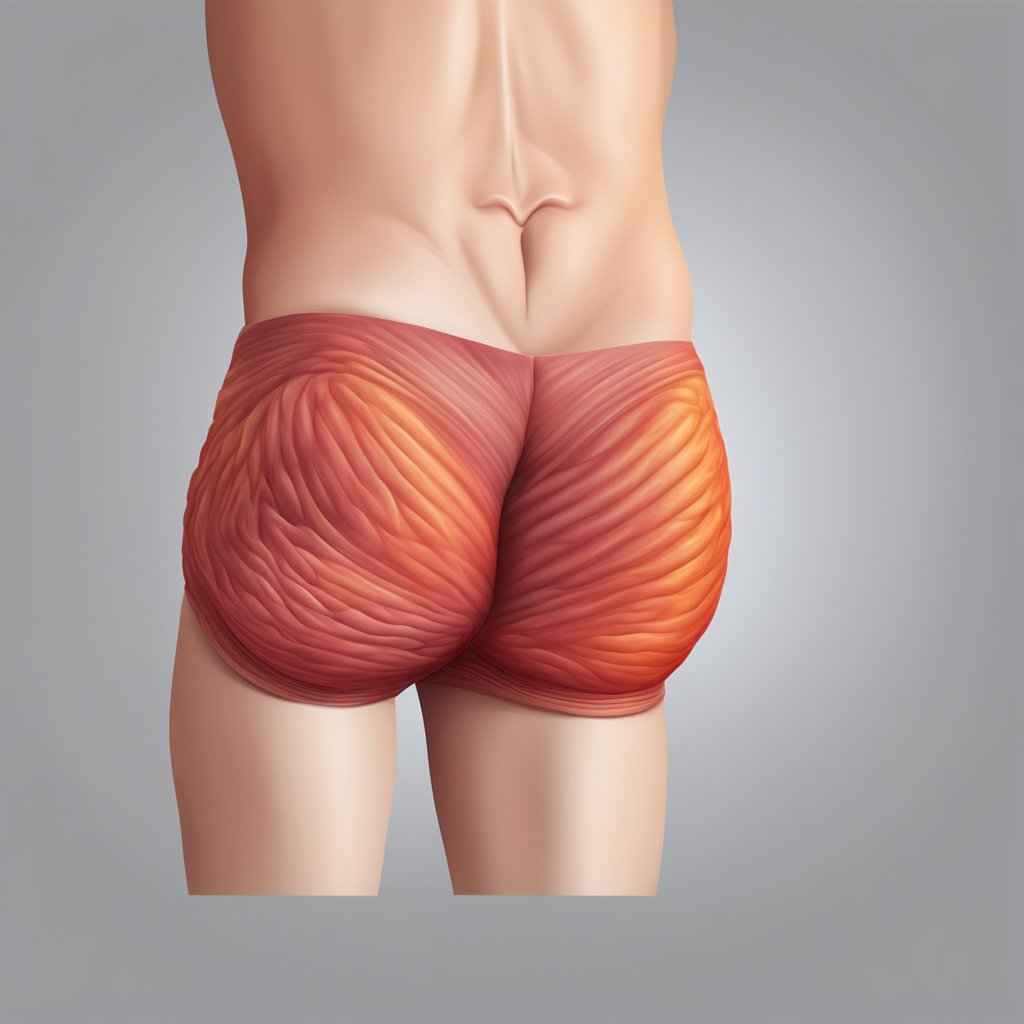Experiencing a painful bump on the buttocks cheek can be both uncomfortable and concerning. Tenderness, swelling, and sometimes redness accompany these bumps, indicating that the area is inflamed or infected. While these symptoms may be alarming, it’s important to understand that numerous skin conditions could be at play. Anything from simple acne to more complex issues such as cysts or abscesses could cause these painful lumps.

If I have a painful bump on my buttocks cheek, seeking a proper diagnosis is crucial to addressing the underlying cause. In some cases, a visual inspection may suffice, but healthcare professionals may need to conduct further tests to rule out serious skin conditions. They can guide me through potential treatment options which may include medication, topical treatments, or in certain cases, surgical removal.
Home remedies and self-care practices play a significant role in managing discomfort and promoting healing when it comes to bumps on the buttocks. Keeping the area clean, applying warm compresses, and using over-the-counter pain relief can offer temporary respite. Additionally, practicing good hygiene and avoiding irritants can prevent future occurrences.
Key Takeaways
- A painful bump on the buttocks cheek could signify a range of skin conditions requiring a professional diagnosis.
- Medical guidance ensures accurate treatment which may range from medications to surgical intervention.
- Effective management includes a combination of self-care practices and preventive measures to alleviate and avert future skin issues.
Understanding Skin Conditions

When discussing skin conditions that lead to painful bumps on the buttocks, it’s important to understand the various causes and the types of bumps that can occur. These bumps can arise from infections, blockages of hair follicles, or the presence of bacteria.
Causes of Painful Bumps
In my experience, painful bumps on the buttocks are often caused by infections in the hair follicle, leading to inflamed, swollen areas. The bacterium Staphylococcus aureus commonly causes these infections. For instance:
- Infection: The introduction of bacteria into the skin, especially Staphylococcus aureus, can lead to painful bumps. Friction and sweat can increase the risk.
- Hair Follicle Blockage: A blocked hair follicle may become inflamed, paving the way for a pimple or a boil to form.
- Bacteria: Certain bacteria, such as Staphylococcus aureus, are notorious for infecting the skin and causing painful reactions.
Key Table of Causes:
| Cause | Description |
|---|---|
| Bacterial Infection | Involvement of bacteria like Staphylococcus aureus leading to inflammation |
| Blocked Hair Follicles | Clogged by dead skin, oils, leading to bumps like pimples or boils |
Types of Bumps
There are several types of bumps that can manifest on the skin:
- Boils: These are painful, pus-filled bumps resulting from infected hair follicles.
- Cysts: Closed pockets of tissue that can be filled with fluid or pus; sebaceous cysts develop from glands that secrete oily matter.
- Pimples: Small pustules or papules that occur when sebaceous glands become clogged and infected, leading to swollen, red lesions filled with pus.
Recognizing these types of bumps is crucial for effective treatment. It’s important to note that while most bumps on the buttocks are benign, any persistent or particularly painful bump should be evaluated by a healthcare provider.
Diagnosis and Professional Care
In determining the cause of a painful bump on my buttocks cheek, I understand the importance of seeking professional medical care for accurate diagnosis and treatment.
When to See a Dermatologist
If the bump on my buttocks cheek is persistent, painful, or changing in appearance, it’s crucial for me to consult a dermatologist. I look for symptoms such as:
- Increased size or number of bumps
- Discoloration or signs of infection (redness, pus)
- Accompanied fever or unusual symptoms
These may indicate a skin condition requiring specialized attention.
Diagnostic Procedures
The process begins with a thorough medical history and physical examination. My dermatologist may use the following diagnostic tools:
- Visual inspection: Evaluating the bump’s size, shape, color, and any accompanying symptoms.
- Palpation: Gently pressing the region to check for tenderness, firmness, or fluctuation.
- Biopsy: In some cases, taking a small tissue sample for further pathological examination.
- Cultures: If an infection is suspected, a sample may be taken to identify bacteria or fungus.
For inflammation or more complex skin conditions, my primary care doctor may refer me to a dermatologist for specialized care. This ensures an accurate diagnosis and the most effective treatment plan for my symptoms.
Treatment Options
When addressing a painful bump on the buttocks cheek, it’s important to consider both medication and potential surgical interventions. The prescribed course of action typically depends on the underlying cause and severity of the bump.
Medications
-
Antibiotics: If the bump is an infection such as an abscess, I might prescribe oral antibiotics to fight the infection. It’s crucial to complete the entire course of antibiotics even if symptoms improve before finishing the medication.
-
Topical Treatments: For less severe cases, or as an adjunct to systemic treatment, I may recommend topical antibiotics or other antimicrobial creams to reduce bacteria on the skin’s surface and promote healing.
- Warm Compresses: Applying warm compresses can help to soothe the pain and encourage drainage, which is particularly beneficial when dealing with an inflamed cyst or abscess.
Surgical Interventions
-
Incision and Drainage: In cases where there is an abscess, incision and drainage may be necessary. This procedure involves making a small cut in the bump to allow the pus to drain out, which typically provides immediate relief from pain.
-
Surgery: Should I determine that the bump is caused by a more significant issue, such as a large cyst or a complicated infection, surgery under general anesthesia might be required to remove it completely. Post-operative care is essential to ensure proper healing and prevent recurrence.
Self-Care and Home Remedies
When I experience a painful bump on my buttocks cheek, I prioritize cleanliness and comfort to aid in healing and reduce discomfort. I’ve found that certain lifestyle alterations and home treatments can be quite effective.
Lifestyle Changes
I make sure to wear loose-fitting, breathable clothing to avoid putting extra pressure on the bump. This helps reduce irritation and allows the area to stay cool, which can promote healing.
- Avoid tight clothing: Tight clothing can irritate the bump.
- Keep the area clean: Ensuring the area is clean reduces the risk of further infections.
Home Treatments
For home treatments, I use a variety of methods. I often start with warm compresses applied to the bump for about 20 minutes several times a day. This can increase blood flow and aid in reducing pain and swelling.
Warm Compresses:
- Use a clean washcloth.
- Soak in warm water, wring out excess.
- Apply to the bump for 20 minutes.
To keep the area clean, I wash the bump gently using antibacterial soap once or twice daily, then pat it dry.
Cleansing Routine:
- Select a mild antibacterial soap.
- Gently wash the area.
- Carefully pat dry – do not rub.
Handwashing is crucial to prevent the spread of infection. I always wash my hands with soap and water before and after touching the affected area. If soap and water aren’t available, I use a hand sanitizer with at least 60% alcohol content.
Hand Hygiene:
- Use hand sanitizer when soap isn’t available.
- Ensure proper handwashing technique.
Prevention and Management
In managing painful bumps on the buttocks cheek, it’s crucial to balance both prevention and recovery. I’ll provide specific strategies to avoid common risk factors and outline care techniques that support effective healing.
Avoiding Risk Factors
To prevent the development of painful bumps, it’s important to minimize skin irritation and reduce pressure in the buttock area:
- Clothing Choices: Opt for loose-fitting, breathable fabrics to decrease friction and sweating.
- Hygiene Practices: Regular cleansing of the area with mild soap can help prevent skin infections. Be sure to dry the skin thoroughly, as moisture can be a breeding ground for bacteria.
Aftercare for Recovery
Following the appearance of a bump, the following aftercare strategies can expedite recovery:
- Skin Care: Gently clean the affected area with antiseptic solutions and apply over-the-counter treatments as recommended by a healthcare professional.
- Rest and Pressure Management: Try to avoid sitting on hard surfaces for long periods. Use cushions when necessary to alleviate pressure.
Frequently Asked Questions
In this section, I will provide answers to common inquiries regarding painful and swollen lumps on the buttocks. Each subsection will cover a specific question for clear understanding.
What are possible causes of a swollen and painful lump on the buttock?
Possible causes for a painful lump on the buttocks include infections like boils or abscesses, skin conditions such as cysts, and in some cases, injuries leading to hematoma or swollen glands.
How can a hard lump on the buttocks be treated?
Treatment for a hard lump on the buttocks can vary widely based on the cause. It may involve antibiotics for infection, warm compresses to alleviate pain, or in certain cases, surgery to remove the growth if it is not responding to other treatments.
What are the distinguishing features of a boil on the buttock?
A boil on the buttock typically appears as a red, swollen, and painful nodule with a white or yellow center filled with pus. It is commonly caused by the infection of hair follicles.
How can you differentiate between cysts and other types of bumps on the buttocks?
Cysts on the buttocks are usually characterized by a fluid-filled sac beneath the skin and may feel smooth to the touch. They move slightly under the skin when pressed, which distinguishes them from other fixed and possibly harder bumps.
What signs might indicate a lump on the buttocks is cancerous?
Although it is rare, signs that might suggest a lump on the buttocks could be cancerous include a rapid increase in size, irregular shape, hardness, a lump that is fixed in place, and showing no signs of pain or inflammation.
What are some effective home remedies for an abscess on the buttocks?
For an abscess on the buttocks, home remedies often involve applying warm compresses to the area to reduce pain and promote drainage. It is important not to squeeze or pop the abscess to avoid further infection. Maintaining hygiene and using over-the-counter pain relief can also provide relief.